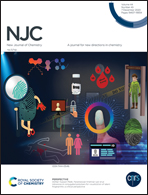Photocatalytic nitrogen fixation on transition metal modified TiO2 nanosheets under simulated sunlight†
Abstract
Transition metal (M = Cu, Fe and Ni) modified TiO2 nanosheets were synthesized via a microwave assisted hydrothermal method. The as-fabricated catalysts were characterized using X-ray diffraction (XRD), electron microscopy, X-ray photoelectron spectroscopy (XPS), nitrogen adsorption–desorption, UV-vis diffuse reflectance spectroscopy (DRS), photoluminescence emission (PL), transient photocurrent–time curves and electrochemical impedance spectroscopy (EIS). The results indicated that the loading of transition metals did not influence the crystal structure and morphology of anatase TiO2, while the specific surface area, the absorption in the visible region and the charge transfer were enhanced. In addition, photocatalytic nitrogen fixation over the transition metal modified TiO2 nanosheets was also evaluated. Under the irradiation of simulated sunlight, transition metal modified TiO2 exhibited better photocatalytic performance and stability than pristine TiO2. Among these samples, Cu/TiO2 with the optimal mass content of 1.0% achieved the best NH4+ generation performance and the evolution rate reached 6.78 mmol g−1 h−1 with the relative standard deviation of 2.33%. Furthermore, a plausible mechanism coupled with interfacial charge transfer (IFCT) over Cu modified TiO2 nanosheets was proposed in our present study.



 Please wait while we load your content...
Please wait while we load your content...